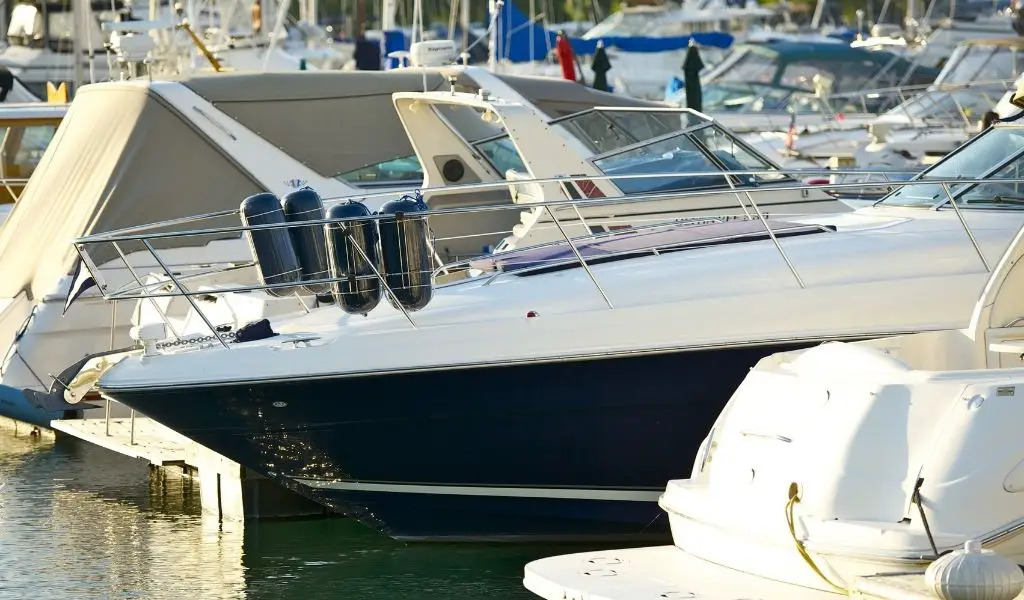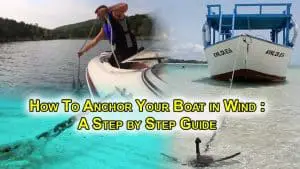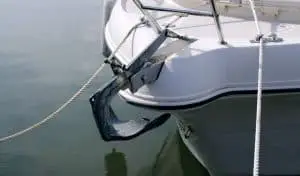Docking a boat seems easy until you do it a few times. A few gashes in your gel coat will make even the boldest of us admit that it isn’t as easy as parking a car. But what exactly makes it so different?
Docking your boat can be simple and look pretty cool if you follow a few steps. First, visualize your approach and have a plan. Decide whether you want to use a parallel or swinging approach to bring your boat alongside the dock. Perhaps it’s best to back your boat in. Allow for wind, current, and other boats. Luckily, if you go in with a plan and consider the right variables, you’ll be docking like a boss in no time.
Properly docking a boat is a skill that every captain must eventually master. We break down the entire process and present it in a logical and easy to learn approach. After you’ve learned how to dock your boat, check out my articles on anchoring and retrieving your boat.
All About the Plan
Docking is all about having a plan. It means you need to weigh all of the factors at play. Which dock are you going to? How are you going to get off the boat? Do you need to go in bow first or stern-to? Do you need a specific side of the boat to the pier for your power cord or gangplank?
Now that you’ve answered those questions, you have an idea of how the boat should wind up when it’s all over. But how will you get it there? You’ll have to consider the handling factors of your boat, and you’ll have to gauge and wind and current and how they’ll affect your docking.
Pivot Point
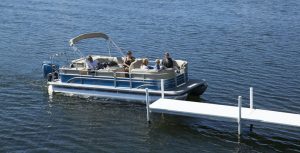
One thing that makes handling boats very different than cars is the concept of the pivot point. Boats turn around a point located about a third of the way from the bow to the stern.
This means that when you turn, the front of the boat is going to turn towards your destination, but the back of your boat is going to swing out and away from the turn. If you are running close to a dock and turn out, your stern might hit the dock. This extra dimension to turning is one of the harder things to envision when operating in close quarters.
Prop Walk
Another thing that makes driving a boat tricky is called prop walk. Prop walk is the effect caused by the wash from your propeller. Outboard and twin-engine boats don’t need to worry much about prop walk, but inboard boats need to consider it and factor it in every time they operate in tight spaces.
Technicalities aside, the net effect of prop walk is that when operating in reverse, most single-engine inboard boats will turn their sterns to port. If you don’t realize what is happening, you’re in for a nasty shock. However, if you know it’s going to happen and you have a plan, you can use the effect to your advantage.
For example, if you are making a tight three-point turn in a marina channel, you’ll want to make sure that you reverse to port. If backing into a slip, you’ll want to ensure that you’re turning into a slip to port. If backing out is required, you want to make sure that the turn out of the slip will be to port. Any turns to starboard are going to be tricky.
Most boats prop walk to port. But if the boat is equipped the prop turning “backward,” then the effect would be reversed, and it would walk to starboard. Twin-engine boats don’t walk since they are usually fitted with one left-hand and one right-hand prop, making the net walk zero.
Wind and Current
The last factor that makes docking a boat tricky involves the weather. The wind will blow the boat along the surface of the water. The current will move the boat along on the surface like a conveyor belt.
If you’re dealing with both wind and current, knowing which one will affect your boat more is tough. If your boat has a lot of windage, then wind will affect it more. If it has a deep draft, then the current will affect it more. If the above- and below-water profiles are similar, wind and current might equal out.
As a skipper who plans, you’ll always be looking for ways to minimize trouble. When the wind is opposite the current, it is difficult to predict how the boat will handle. It’s better to sit back and wait for tidal currents to slack, and then you’ll only have to worry about the wind. Or set out when the current is minimal, and get a feel for how it’s going to affect the boat while docking. If you can’t wait, then choose the dock with the most straightforward approach and the fewest obstacles.
Different Boats for Different Folks
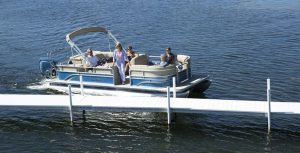
Once you master the basics of the pivot point and gauging the wind and current, docking will become more like riding a bicycle and less like landing a 747. But every time you hop behind the wheel of a new vessel, everything is a little different.
The engine configuration of the boat has a big effect on handling. Outboard and inboard/outboard (IO) boats have vectored thrust. Like a Harrier fighter jet, when you turn the wheel, the prop also moves. This means that you can begin turning your boat from a dead stop. Just turn the wheel, add power, and the bow of the boat will move one way or another in forward or reverse.
Inboard engines will have an externally mounted rudder, which is moved by the helm, but the prop remains stationary. To turn, the rudder must have some water flowing over it. If you are powering in forward, prop wash over the rudder provides some of that. With a little practice, you can nudge the bow one way or another with a burst of forward power, but not like you can with an outboard.
Twin Engines
Offshore you might like the redundancy of having two engines. But near the dock, you’ll like having two engines even more. While you can drive a twin-engine boat just like a single-screw vessel, having power on each side of the boat means you can power each one independently.
As a simple example, imagine a twin-engine boat at a full stop. You put the port engine ahead, and you put the starboard engine in reverse. What will happen? All things being equal, the boat will begin to spin to starboard, maybe within its length.
The farther apart the two engines, the more pronounced the effect will be. Vessels with the engines very far apart, like catamarans, can combine rudder inputs with differential thrust. Some boats can move nearly sideways in this configuration.
One the other hand, outboard twin engines might be set up so close together that you can get more of a result by just using the wheel. It all depends on the boat design.
Tip: Practice with an App
Did you know there’s an App to learn how to dock your boat? The app, developed by Hafenskipper, allows you to practice docking, parking in a slip and turning in close quarters. It has settings for professional captains as well as the novice skipper. You can download the App from the App Store, Google Play, and Microsoft.
Basic Alongside Docking Technique
Most first-timers are driving single-engine, outboard boats. Center consoles, runabouts, skiffs, and pontoon boats all have very similar docking characteristics.
Always try to plan your approach and docking with the wind or current pushing you away from the dock. With the wind pushing you away from the dock, you can always stop and allow the boat to drift back if you need a do-over.
When starting, it’s easier to approach the dock bow first. Approach the dock at an angle anywhere from about 30 to 45 degrees. Come in slowly, and when the boat is a few boat lengths away, put the engine in neutral. How many boat lengths will have to be judged based on how far the boat will drift once you stop the forward thrust. Your goal is to be nearly at a stop when alongside the dock. A strong wind pushing you off the dock may mean you leave the power in longer, while wind blowing you toward the dock may mean you cut power sooner.
If you get it wrong, nudge the power into forward or reverse for just a moment. Small corrections will do. If you’re going slowly, you should have plenty of time to play with it to get it right.
As you come alongside the dock, use reverse power as your brakes. Apply enough power that the boat comes to a stop alongside the dock. At the same time, turn the wheel towards the dock. Now the stern will pull towards the dock while you stop, aligning the boat parallel to the dock. If you have an inboard vessel, you can use prop walk to the same effect.
Take it slow, and don’t be afraid to take a do-over. And don’t let other “seasoned” boaters fool you. Docking quickly and with lots of power only puts money in the fiberglass repair man’s pocket.
Check out this video of how to dock a small boat.
Tying Off Your Boat
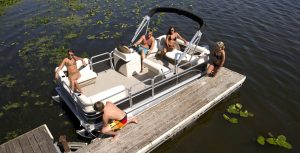
Before setting out, you’ll need to know three knots to secure a boat properly. Luckily, these three knots are easy to tie, and you will use them often enough that you probably won’t forget them.
The first knot to know is called a cleat hitch. This secures a line to a cleat, both on your boat and on the dock. While you can loop the line around a dozen times and call it good, there is a right way and a wrong way to tie a cleat hitch. A proper cleat hitch is secure and will not come undone.
The second to know is known as a bowline. This creates a loop in the end of a line. It’s versatile and strong. You can use a bowline to tie to a piling, through a large dock cleat, or even to secure your anchor temporarily.
The last knot to know is a clove hitch. This knot can be used to wrap a line around a piling. When done right, the knot gets more secure as the boat pulls on it.
With these three knots, you should be able to tie off to any dock. But properly tying your boat to the dock requires more than just knots. You’ll also need to know how to set up the lines properly.
For this, you’ll need lines from the bow and stern to keep the boat near the dock. You’ll also need spring lines, which run diagonally from the boat to the dock. Spring lines keep the boat centered in the slip, not allowing it to move forward or aft.
Your lines need to have enough slack in them that the tide can go up and down, and the boat will remain nearly stationary. If your lines are too short, the boat could hang off them at low tide. That’s a good way to pull out your deck cleats and give the local fiberglass guy some more business. If the lines are too long, your boat will be drifting all over the place.
One last note about docking: Don’t be ashamed to use your fenders. Every pilot lands a little hot from time to time, and fenders can save the day. They also prevent knicks and chips in your gel coat while the boat is docked.
Conclusion
Like anything else, docking takes practice. Unfortunately, most people avoid docking except when necessary. The best policy, however, is to dock at as many places as often as possible. Dock your boat in every orientation. Learn how it handles. Go out with some wind. Find a place where it’s easy to wave off and try again.
Luckily there’s no magic to docking. All it takes is recognizing potential problems and planning for them. While that’s tricky for a beginner, by being conservative and practicing often, you’ll be docking like a pro in no time.

